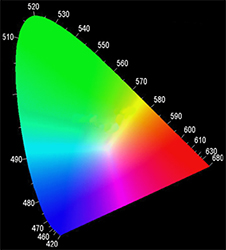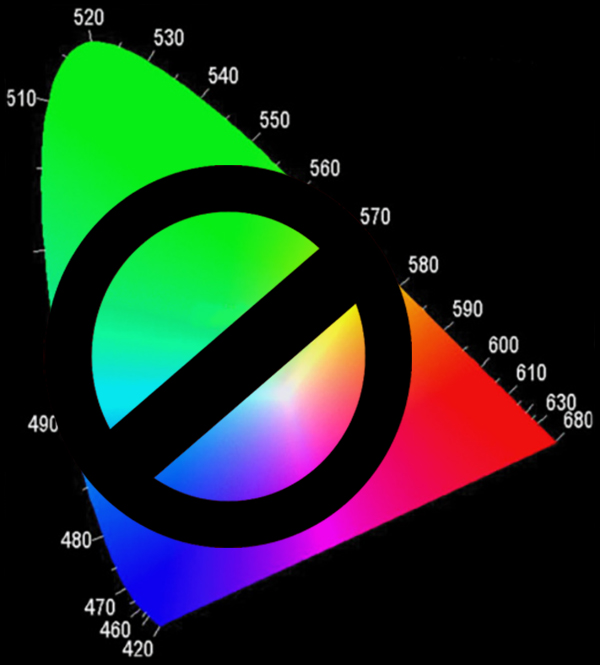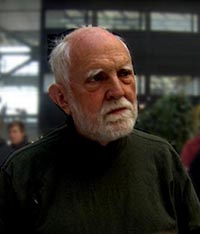
One way to escape the difficulties suggested in Part One is to factor out the observer altogether and content ourselves with regarding colors as being constituted by spectral power distributions. This is the world of physical color. Color in this sense can be measured with great precision and needs to be understood very well if one is to produce and control colorants of all sorts as well as the lighting under which they are to be seen. Two pigments may look identical and yet have different spectral power distributions. If each of them is separately mixed with a third pigment, the two mixtures may very well look different. Or a restorer of paintings may touch up an area and achieve a perfect match in the studio only to find that when the painting is shown in the lighting of the gallery the touched- up area is plainly visible.
On the other hand, one who thinks that colors are simply spectral power distributions may be inclined to say silly things, such as “white light is a mixture of all colors.” This despite the fact that the original decomposer of white light, Isaac Newton, cautioned, “the rays are not colored.” Furthermore, such a devotee of physical colors would be unable to understand how it is that a monochromatic yellow light could be visually indistinguishable from a mixture of two lights that look respectively red and green. In short, he would be unable to understand how color television is possible. This brings us back to our second case, in which we might refer to the yellow as a psychophysical color.
Psychophysical Color & The CIE System
Psychophysics is concerned with an organism’s behavioral response to physical stimuli. In the case of color, we know that human visual systems heavily filter spectral energy information in their environment, reducing it, in daylight conditions, to the response ratios of three photoreceptor classes. In the first half of the 20th century, information about the actual response characteristics of the photoreceptors was unobtainable, so the color matches made by observers under carefully controlled conditions were averaged and mathematically manipulated to yield the 1931 CIE Standard Observer. This “Observer” (actually a lookup table), along with the specification of illuminant standards enables one to calculate color mixtures that correspond well with the color mixtures that real people make. The CIE system and related psychophysical color spaces have been developed and improved upon over the years. For the appropriate standard viewing and illumination conditions, the CIE Observer will predict a match between our “television patch” yellow and our paint chip. They are thus the same psychophysical color.

The CIE chromaticity diagram tells us a great deal about color matching, but it is not a guide to color appearance.
Despite the mathematical sophistication and practical success of colorimetry, we must bear in mind that its proper business is mixing and matching. It is common to see colored renditions of the tongue-shaped CIE chromaticity diagram. What is intended to be an intuitive aid in reading the figure all too readily makes the unwary suppose that the color sample represented by a point in the diagram looks like the color of the region in which the point appears, and that a straight line from a spectral locus to the white point will be a line of constant hue, with only the saturation varying. Typically this is not the case; in the chromaticity diagram the lines of constant hue are mostly curved to a greater or lesser extent. Hue shifts with desaturation.
The domain of color psychophysics can extend beyond mixing and matching to the whole set of behavioral responses to spectral stimuli. So understood, it could be extended to animals and machines. It is strictly third-person in perspective and treats the subject as a black box. Its aim is to discover patterns of reliable response to a controlled set of targets. Computational modelers can then develop a set of functions that will translate those inputs to their associated outputs. The set of functions could be realized in either hardware or wetware, depending on the nature of the system that is being modeled. Although the data may be artificially structured in earlier stages of development, the aim of the modelers is to refine their product so as to approximate ever more closely the conditions of the setting in which the modeled object either does operate, in the case of a natural system such as a honeybee, or is intended to operate, as in the case of a robot.
Now suppose that we have a robot capable of operating effectively in a natural visual setting. It derives shape from shading, recognizes occluded objects, sorts paint chips, separates luminance from reflectance, and so on. In short, it deals with the environment of spectral power distributions in much the same way as we do. Does it see color?
If your answer to this question is “yes”, you will accept physical and psychophysical color and take psychological color to be a mere appearance. But if your answer is “no,” you will not only take colored shadows to be truly colored, you will regard physical color and psychophysical color (which is really physical color that is filtered by a receptor apparatus) as not being full-blooded color at all, but merely the normal stimuli for psychological color, that is, color as an experienced quality. Inevitably, this demands a first-person perspective, the view from within the black box.
In the Black Box
Life inside the box can be pretty nice. In contrast to the cold impersonality of atoms and the void, it is quality rich and, well, colorful. The box provides not just a sensory rush, but a structured and supplemented array as well. Outside there are light and darks, but the inside adds whiteness and blackness. Outside there is a wavelength continuum, but inside there is a configuration of unitary and binary hues.
This is, of course, just a latter-day version of what the philosopher- mathematician Whitehead once called “the bifurcation of nature.” It was introduced into Western culture by Galileo and Descartes, and philosophers have been trying to bridge the divide ever since. It would be both presumptuous and vain to undertake here the construction of yet another bridge, but it might be interesting to consider some aspects of the problem from the standpoint of color studies.
First of all, the human body, including the nervous system, is a part of nature; it is made of the same stuff, and subject to the same laws. It is becoming increasingly difficult to think of the mind as something distinct from the physical world as more and more of the processes and features of our mental lives are not only mapped onto brain processes, but are shown to depend upon them. Just as striking is the realization that, contrary to Descartes, the greater part of our cognition and volition takes place at an unconscious level. That said, many reflective people are uncomfortable with the claim that conscious events are identical with brain events. Is my pleasure at the deployment of green in a Degas painting nothing more than a pattern of neural activity? Complexity aside, does the difference between us and robots just come down to the difference between hardware and wetware?
There is a second bifurcation that is exacerbated by the first: the split between my consciousness and yours. In Aristotle’s view, qualities were part and parcel of the physical world. Perception involved a process whereby a property of the world, which he called a “form,” impressed itself on the mind of the percipient (hence our word “information”). Red is out there in the world, and it imprints itself on your mind just as it does on mine, so the question of whether you and I have the same color experience doesn’t arise. But after Galileo and Descartes, the fact that a spectral pattern strikes your retina in much the same way as it does mine fails to guarantee that the color that is generated in your mind is like the one that is generated in mine. It should come as no surprise that the question as to whether what I experience as red you experience as green was first raised in the seventeenth century in the writing of Locke. The “inverted spectrum” problem has plagued the philosophically minded ever since.

Do you see what I see?
Continue to the 3rd and last post in this series.
About the Author

C L Hardin is Professor of Philosophy, Emeritus at Syracuse University. He is the author of Color for Philosophers: Unweaving the Rainbow (Hackett: 1988, 1993).



Leave a Reply